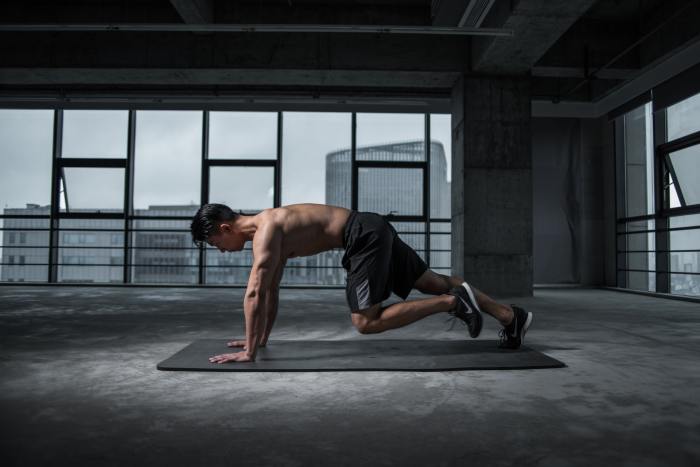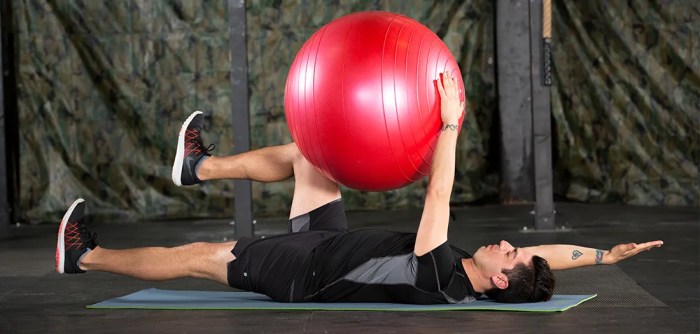
Our core, often overlooked, is the powerhouse of our body. It’s not just about sculpted abs; it’s the foundation for stability, strength, and overall well-being. Core stability exercises are a vital part of a healthy lifestyle, benefiting everyone from athletes to everyday individuals.
Imagine effortlessly lifting heavy objects, maintaining perfect posture while working at your desk, and confidently navigating uneven terrain. These are just a few examples of how a strong core can improve your daily life. By understanding the muscles involved and engaging in targeted exercises, you can unlock a world of benefits, from reducing back pain to enhancing athletic performance.
What is Core Stability?
Core stability refers to the ability of your body to control and stabilize your trunk, particularly the lumbar spine (lower back), pelvis, and abdomen. It’s not just about having strong abdominal muscles; it’s about the coordinated effort of multiple muscle groups working together to maintain proper posture, balance, and control movement. A strong core provides a solid foundation for all your movements, protecting your spine and enhancing your overall performance.
Importance of Core Stability
Core stability is crucial for overall health and well-being. It plays a significant role in:
- Improved Posture: A strong core helps maintain proper spinal alignment, reducing the risk of back pain and other musculoskeletal issues.
- Enhanced Balance and Coordination: A stable core provides a base for controlled movements, improving your balance and coordination, especially during activities like walking, running, and sports.
- Reduced Risk of Injuries: A strong core acts as a natural shock absorber, protecting your spine from injury during physical activity and everyday movements.
- Increased Strength and Power: A stable core allows for efficient transfer of force from your lower body to your upper body, enhancing your strength and power in various activities.
- Improved Breathing and Digestion: Core muscles play a role in supporting respiratory function and digestive processes.
Muscles Involved in Core Stability
The core muscles encompass a network of muscles that surround your trunk, including:
- Transverse Abdominis: This deep abdominal muscle acts like a corset, wrapping around your waist and providing stability to your spine.
- Rectus Abdominis: The “six-pack” muscle, located in the front of your abdomen, helps with flexion and rotation of the spine.
- Obliques: These muscles run diagonally along your sides, assisting with rotation and lateral flexion of the spine.
- Erector Spinae: These muscles run along your spine, providing support and extension.
- Diaphragm: The primary muscle of respiration, the diaphragm also plays a role in core stability.
- Pelvic Floor Muscles: These muscles form the floor of your pelvis, supporting your organs and contributing to core stability.
Everyday Activities Requiring Core Strength
You might be surprised to learn how many everyday activities rely on core strength:
- Standing: Maintaining an upright posture requires core engagement to keep your spine aligned.
- Walking: Walking involves a coordinated effort of your core muscles to maintain balance and stability.
- Lifting Objects: Proper lifting techniques involve engaging your core to protect your spine and prevent injury.
- Household Chores: Activities like vacuuming, gardening, and cooking require core strength for stability and control.
- Playing with Children: Running, jumping, and playing with your children requires core strength for balance and coordination.
Benefits of Core Stability Exercises
Core stability exercises go beyond just strengthening your abdominal muscles. They play a crucial role in enhancing overall physical function and well-being. By strengthening the core, you can experience numerous benefits that impact your daily life and athletic performance.
Improved Posture and Reduced Back Pain
A strong core provides the foundation for good posture. When your core muscles are weak, your body may compensate by slouching or leaning forward, putting undue stress on your back. Core stability exercises help strengthen the muscles that support your spine, improving your posture and reducing the risk of back pain.
- Strengthening the deep abdominal muscles: These muscles, including the transverse abdominis, help stabilize the spine and prevent excessive movement. By strengthening these muscles, you improve your posture and reduce the strain on your back.
- Improved spinal alignment: Strong core muscles help maintain proper spinal alignment, reducing the risk of back pain and discomfort. They act like a natural corset, supporting your spine and preventing it from curving excessively.
- Reduced stress on the back: When your core is weak, your back muscles have to work harder to support your body. Core stability exercises distribute the load more evenly, reducing stress on your back and preventing pain.
Impact on Athletic Performance and Injury Prevention
A strong core is essential for athletes in all sports. It provides the stability and power needed for explosive movements, efficient energy transfer, and enhanced balance.
- Increased power and explosiveness: A strong core allows for greater force generation and power transfer, improving performance in activities like jumping, throwing, and sprinting.
- Enhanced balance and coordination: A strong core helps maintain balance and stability, reducing the risk of falls and injuries. This is crucial for athletes in sports that require quick changes in direction or sudden movements.
- Improved injury prevention: A strong core helps protect your body from injuries, especially in the back, hips, and knees. It acts as a shock absorber, reducing the impact of forces during athletic activities.
Enhanced Balance and Coordination
Core stability exercises are essential for improving balance and coordination. They strengthen the muscles responsible for maintaining equilibrium and controlling movement.
- Improved proprioception: Core stability exercises enhance proprioception, which is the body’s awareness of its position in space. This awareness is crucial for maintaining balance and coordination.
- Enhanced reaction time: A strong core allows for quicker reaction times, enabling you to respond more effectively to changes in your environment and maintain balance.
- Improved stability during movement: A strong core provides a stable base for movement, allowing for smoother and more controlled transitions. This is particularly important for activities that require balance and coordination, such as walking, running, and dancing.
Types of Core Stability Exercises
Core stability exercises encompass a wide range of movements that target the muscles responsible for supporting your spine and maintaining proper posture. These exercises are essential for improving balance, reducing the risk of injuries, and enhancing overall physical performance.
Plank Variations
The plank is a foundational core stability exercise that engages multiple muscle groups simultaneously. It is a static exercise that involves holding a specific position for a certain duration, challenging your core muscles to maintain stability. There are several variations of the plank, each targeting different muscle groups and offering varying levels of difficulty.
- Standard Plank: This is the basic plank position, where you hold your body in a straight line from head to heels, supported by your forearms and toes. Engage your core muscles to keep your body stable and avoid sagging or arching your back.
- High Plank: Similar to the standard plank, but with your hands instead of forearms supporting your weight. This variation increases the demand on your shoulder muscles.
- Side Plank: This variation targets your obliques, the muscles responsible for side-to-side trunk rotation. Start by lying on your side, supporting your body weight with your forearm and the edge of your foot. Keep your body in a straight line from head to heels, engaging your core to prevent your hips from dropping.
- Forearm to Hand Plank: This variation involves transitioning from a forearm plank to a high plank, engaging your core muscles to maintain stability during the movement.
Bridges
Bridge exercises strengthen your glutes, hamstrings, and core muscles, contributing to overall stability and balance. They are a dynamic exercise that involves lifting your hips off the ground while maintaining a stable core.
- Standard Bridge: Lie on your back with your knees bent and feet flat on the floor. Engage your core and glutes to lift your hips off the ground, forming a straight line from your shoulders to your knees. Lower your hips back down slowly, maintaining control.
- Single-Leg Bridge: This variation increases the challenge by lifting one leg off the ground while performing the bridge.
Engage your core muscles to maintain balance and prevent your hips from tilting.
- Hip Thrust: Similar to the bridge, but performed with your upper back resting on a bench or elevated surface. This variation allows for greater range of motion and increased activation of your glutes.
Rotations
Rotation exercises target your obliques and other core muscles involved in twisting movements. These exercises help improve spinal mobility, enhance core strength, and contribute to better balance and coordination.
- Russian Twists: Sit on the floor with your knees bent and feet flat on the ground. Lean back slightly, engaging your core muscles. Twist your torso from side to side, keeping your back straight and avoiding excessive momentum.
- Wood Chop: Stand with your feet shoulder-width apart and hold a light weight in both hands. Swing the weight from one side of your body to the other, mimicking a wood chopping motion.
Engage your core muscles to control the movement and prevent your torso from twisting excessively.
- Anti-Rotation Press: Stand with your feet shoulder-width apart and hold a weight in one hand. Engage your core muscles to resist the weight’s pull and prevent your torso from rotating as you press the weight upward.
Food and Related Products

A strong core is essential for overall health and well-being, and proper nutrition plays a crucial role in supporting core strength and stability. By consuming the right foods, you can provide your body with the necessary nutrients to build and repair muscle tissue, enhance recovery, and optimize your core training efforts.
Foods for Muscle Growth and Recovery
Consuming a balanced diet rich in protein, carbohydrates, and healthy fats is essential for muscle growth and recovery. Here are some examples of foods that can support your core stability exercises:
- Lean Protein Sources: Chicken breast, fish, tofu, beans, lentils, and Greek yogurt provide essential amino acids for muscle building and repair.
- Complex Carbohydrates: Brown rice, quinoa, oats, and sweet potatoes provide sustained energy for workouts and aid in muscle glycogen replenishment.
- Healthy Fats: Avocados, nuts, seeds, and olive oil provide essential fatty acids that support hormone production and cell function, crucial for muscle recovery.
Products for Core Strength Training
Various products can enhance your core strength training and help you achieve optimal results. These tools provide resistance, stability, and support, allowing you to challenge your core muscles effectively.
- Resistance Bands: These versatile tools offer adjustable resistance, making them suitable for various core exercises, such as band pull-aparts, anti-rotation presses, and planks.
- Stability Balls: These inflatable balls provide an unstable surface, challenging your core muscles to maintain balance and stability during exercises like ball crunches, planks, and rollouts.
- Medicine Balls: These weighted balls add an extra challenge to core exercises, enhancing strength and power. They can be used for throws, slams, and anti-rotation presses.
- Kettlebells: These cast-iron weights offer a unique grip and can be used for various core exercises, including swings, snatches, and Turkish get-ups, engaging multiple muscle groups.
Product Creation
The world of fitness is constantly evolving, and with the growing awareness of the importance of core stability, there’s a need for innovative products that enhance core strengthening exercises. One such product is the Core Stability Mat, designed to provide a unique and effective platform for various core exercises.
Core Stability Mat Features and Benefits
The Core Stability Mat is designed to enhance core stability exercises by incorporating several key features.
- Textured Surface: The mat features a textured surface that provides enhanced grip, preventing slipping during exercises and promoting stability. This textured surface also provides a gentle massage effect, improving blood circulation and reducing muscle soreness.
- Integrated Resistance Bands: The mat has integrated resistance bands that can be used for a variety of exercises, adding an extra challenge to core workouts. This allows users to increase the intensity and effectiveness of their workouts.
- Adjustable Height: The mat’s height can be adjusted to suit different user needs and exercise types. This allows for greater versatility and accommodates individuals with varying fitness levels.
- Portable and Lightweight: The Core Stability Mat is designed to be lightweight and portable, making it easy to transport to the gym or use at home. This feature encourages regular exercise and promotes convenience.
The benefits of using the Core Stability Mat are numerous. It helps users improve their core strength and stability, enhance their balance and coordination, and reduce the risk of injuries. The integrated resistance bands add an extra dimension to workouts, promoting muscle growth and endurance. The adjustable height feature allows users to personalize their workouts and target specific muscle groups.
Marketing Strategy
To effectively market the Core Stability Mat, a comprehensive strategy is essential.
- Target Audience: The target audience for this product includes fitness enthusiasts, athletes, individuals seeking to improve their core strength, and those recovering from injuries. The marketing campaign should focus on highlighting the benefits of the product for each segment.
- Online Marketing: Leverage social media platforms, fitness blogs, and online advertising to reach the target audience. Collaborate with fitness influencers and trainers to promote the product and showcase its effectiveness.
- Offline Marketing: Partner with gyms, fitness studios, and physical therapy centers to distribute samples and offer demonstrations. Participate in fitness events and expos to reach a wider audience.
- Content Marketing: Create informative blog posts, videos, and articles highlighting the benefits of core stability exercises and the role of the Core Stability Mat in enhancing these exercises. Share these resources on social media and through email marketing.
- Special Promotions: Offer discounts, bundles, and free shipping to incentivize purchases. Run contests and giveaways to generate excitement and brand awareness.
Bed Breakfast Inns

Core stability exercises can significantly benefit both innkeepers and guests at bed and breakfast inns. By incorporating these exercises into their daily routines, innkeepers can improve their overall well-being and enhance their ability to provide exceptional service. Guests, on the other hand, can benefit from a fitness program designed to improve their core strength and flexibility, leading to a more enjoyable and rejuvenating stay.
Fitness Program for Guests
A well-designed fitness program can cater to the diverse needs of guests at a bed and breakfast inn. This program should focus on core stability exercises that are accessible, enjoyable, and beneficial for individuals of varying fitness levels.Here is a sample fitness program for guests:
Warm-up
- Gentle stretching: Start with light stretches targeting major muscle groups, including the neck, shoulders, back, hips, and legs. This prepares the body for the workout and reduces the risk of injury.
- Light cardio: Engage in low-impact cardiovascular exercises like walking or jogging in place for 5-10 minutes. This warms up the muscles and increases blood flow.
Core Stability Exercises
- Plank: This classic exercise engages multiple core muscles, including the abs, obliques, and lower back. Hold the plank position for 30-60 seconds, focusing on maintaining a straight line from head to heels.
- Bird dog: This exercise improves balance and coordination while strengthening the core and back muscles. Alternate extending one arm and the opposite leg, keeping the core engaged and the back straight.
- Side plank: This exercise targets the obliques and improves stability. Hold the side plank position for 30-60 seconds, maintaining a straight line from head to feet.
Cool-down
- Stretching: Engage in gentle stretches targeting the core muscles, including the abs, obliques, and lower back. Hold each stretch for 30-60 seconds, breathing deeply.
- Relaxation: Take a few minutes to relax and allow your body to recover. This can involve deep breathing exercises or meditation.
Frequency
- Guests can participate in this fitness program 2-3 times per week, depending on their fitness level and preferences.
- Encourage guests to listen to their bodies and adjust the intensity and duration of the exercises as needed.
Brochure Promoting the Fitness Program
A well-designed brochure can effectively promote the fitness program to guests. Here are some key elements to include:
Headline
- Use a catchy headline that highlights the benefits of the fitness program, such as “Strengthen Your Core, Revitalize Your Stay” or “Discover a Healthier You at Our Inn.”
Images
- Include high-quality images that showcase the fitness program in action, such as guests performing core stability exercises in a scenic setting.
Benefits
- Clearly Artikel the benefits of participating in the fitness program, including improved core strength, flexibility, balance, and overall well-being.
Program Description
- Provide a detailed description of the fitness program, including the warm-up, core stability exercises, and cool-down routines.
Call to Action
- Encourage guests to participate in the fitness program by including a clear call to action, such as “Book Your Stay and Experience the Benefits” or “Start Your Fitness Journey Today.”
Cooking and Culinary
Core stability plays a crucial role in the kitchen, enabling chefs and home cooks to perform culinary tasks with precision, control, and endurance. Strong core muscles provide the foundation for maintaining balance, stability, and efficient movement, which are essential for preparing meals.
Core Stability and Culinary Skills
A strong core enhances culinary skills by:
- Improved Balance and Stability: Standing for long periods, chopping, stirring, and kneading require a stable base. Core muscles act as a natural brace, preventing fatigue and maintaining balance.
- Enhanced Precision and Control: Fine motor skills, such as chopping vegetables or decorating desserts, rely on precise hand movements. A strong core provides a stable platform for these movements, leading to better control and accuracy.
- Increased Endurance: Cooking can be physically demanding, requiring repetitive movements and sustained effort. A strong core improves stamina, allowing you to work for longer periods without fatigue.
- Reduced Risk of Injuries: Repetitive movements in the kitchen can lead to back pain, neck pain, and other musculoskeletal injuries. Core stability exercises strengthen the muscles that support the spine, reducing the risk of these injuries.
Recipe Requiring Core Strength
Here is a recipe for a “Core-Strengthening Salad” that requires core strength during preparation:
Core-Strengthening Salad
Ingredients:* 1 head of romaine lettuce, chopped
- 1 cup chopped bell peppers
- 1/2 cup chopped cucumber
- 1/4 cup chopped red onion
- 1/2 cup chickpeas, drained and rinsed
- 1/4 cup chopped fresh parsley
- 1/4 cup crumbled feta cheese
- 1/4 cup olive oil
- 2 tablespoons lemon juice
- Salt and pepper to taste
Instructions:
1. Chopping
Chopping vegetables requires core engagement to maintain stability and control. Stand with feet shoulder-width apart, engage your core, and use a sharp knife to chop the vegetables.
2. Mixing
Combine all ingredients in a large bowl. Use your core to stabilize your body while you toss the salad to ensure even distribution.
3. Serving
Serve the salad immediately or store in the refrigerator.
Cooking Class Focused on Core Stability and Healthy Eating
This cooking class aims to educate participants about the importance of core stability in the kitchen and promote healthy eating habits. Class Curriculum:* Introduction to Core Stability: Discuss the benefits of core stability for cooking and everyday life.
Core Exercises for the Kitchen
Demonstrate and practice core exercises that can be easily incorporated into daily cooking routines.
Healthy Eating Principles
Learn about the importance of balanced nutrition and how to make healthier food choices.
Core-Strengthening Recipes
Prepare and enjoy a meal that incorporates core-strengthening ingredients and techniques. Class Format:* Interactive demonstrations and hands-on activities.
- Group discussions and Q&A sessions.
- Recipes and nutritional information provided to participants.
- Opportunities for participants to practice core exercises during cooking preparation.
Investing in core stability exercises is an investment in your overall health. It’s a journey of strengthening your foundation, leading to improved posture, reduced risk of injury, and enhanced physical capabilities. Whether you’re a seasoned athlete or simply seeking a healthier lifestyle, incorporating core stability exercises into your routine can make a world of difference.
Essential FAQs
What are some examples of core stability exercises?
Common core stability exercises include planks, bridges, bird dogs, and Russian twists. These exercises target various muscle groups in your core, promoting stability and strength.
How often should I do core stability exercises?
Aim for 2-3 core stability workouts per week, incorporating a variety of exercises to target different muscle groups. Listen to your body and adjust the frequency and intensity based on your fitness level.
Can core stability exercises help with weight loss?
While core stability exercises primarily focus on strength and stability, they can contribute to overall calorie expenditure, which can support weight loss. Combining core work with cardio and a balanced diet can be effective for weight management.






